|
This rocket boost glider called the Dyna-Soar was powered by
American Telasco's version of the
Jetex 50 engine. Jetex
rocket engines were quite popular with model airplane, boat, and
car builders through the early 1970s, at which point the fuel supplies
began to disappear. Most Internet sources posit that
Imperial Chemicals Industries (ICI) ceased making the fuel pellets
due to a combination of liability and regulation issues. ICI, based
in Scotland, manufactured the
Jetex fuel pellets* from a measured blend of guanidine nitrate,
2,4-dinitroresorcinol, potassium nitrate (aka saltpeter), iron oxide,
kaolin, and asbestos. Today, obtaining the required chemicals, or
even doing an Internet search for them (as I just did), will probably
get you a big red flag in the Department of Homeland Security's
database. There are probably a couple agents on the way to my house
as I write this.
* See the
Jetex Propulsion Lab for a incredible bit of information on
the motors and the fuel.
Rocket (Jetex) Powered Dyna-Soar
Designed and tested by Paul Del Gatto
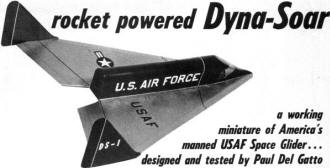
Dyna-Soar, the manned space glider, is an incredible flying machine.
Compared with this Mach 25 terror, even the famous X-15 is a toy.
Boosted aloft by a Martin Titan, it will combine the high speed
of the ballistic missile with controlled, accurate flight of manned
aircraft.
Dyna-Soar's pilot will shorten or lengthen its range by thousands
of miles, changing course to reach a landing site. He can choose
fields as far apart as Point Barrow, Alaska and San Diego. Able
to operate subsonic, transonic, supersonic and hypersonic, Dyna-Soar
will be capable of operating like a large, fast aircraft when approaching
an airport.
Later developments of Dyna-Soar for weapons-system and escape
missions and to circle the moon will take various combinations of
Saturn boost stages.
Surprisingly, a model Dyna-Soar is easier to make than many a
free-flight design. Deltas like Dyna-Soar long ago demonstrated
their performance and stability capabilities. The Jetex Pay-Loader
"150" rocket motor with its augmenter tube provides plenty of push
and the craft presents no adjustments problems.
Your Dyna-Soar, built as a unit, is practically complete before
lifting it from the workbench. Only the fins, part of the elevons
and the landing skid remain to be added.
Since weight and balance are important, the craft should be covered
with lightweight Silkspan tissue and colored dopes should. be used
sparingly. Follow the hardnesses of balsa specified.
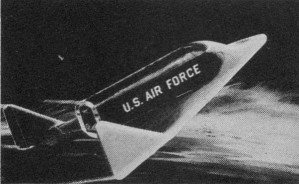
U.S. Air Force's rocket boost glider.
Wing: Pin down 1/8" x 5/8" hard-balsa tapered
leading edges and wing trailing edge pieces, followed by medium
1/8" x 3/8" balsa center-section pieces. Fit and double-cement in
position 1/8" x 3/8" medium ribs and diagonal pieces.
Assemble built-up portions of the "elevons" using hard 1/16"
x 1/4" trailing edge pieces and medium 1/16" x 1/8" and 1/8" -sq
cross pieces where required. Aft sheet-balsa pieces (elevens) are
added later.
It is important that this procedure be followed in making the
elevons ... for each elevon pin down and cement to wing trailing
edge the four main cross pieces; attach the elevon trailing edges
flush with the top of the cross pieces, then the diagonals. Elevon
cross sections (on side view) are obtained later by sanding the
bottoms of the elevons cross pieces and diagonals to match the 1/16"
thick elevon trailing edges.
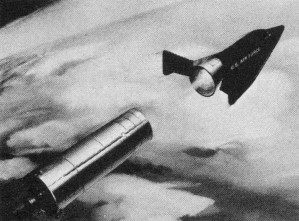
Boeing is prime contractor for system and the
piloted glider.
Fuselage: Cut formers from medium sheet balsa,
noting thicknesses. Erect formers F-5, F-5B, F-6, F-7 and F-8 on
center section pieces, then slip augmenter tube into position. Tube
is rolled to shape from .005" aluminum 2-5/8" wide plus allowance
for an overlapping seam.
After erecting formers F-1 and F-2, cement in motor mount. This
is assembled from 3/32" medium balsa base (full body width) and
1/16" thick plywood overlay 3/4" wide (to which metal motor-mounting
bracket is screwed).
Before sheet covering the fuselage make sure you understand the
hatch construction. Fuselage sides are 1/16" medium balsa sheet,
extending forward to 1/8" sheet fill-in cabin nose piece. Sides
are feathered together where they meet at the nose. Fill in where
necessary with balsa scraps.
Forward portion of removable hatch is carved from soft balsa
block 5/8" thick. Hatch extends to F-4. To complete hatch, insert
formers F-3 and F-4 and plank with soft 1/16" sheet. When thoroughly
dry, model is removed from work surface.
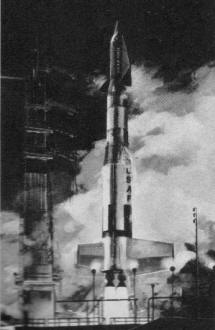
Dyna Soar will be boosted into space by modified
Titan III missile as seen above.
Final assembly: Add 1/16" x 3/4" soft-balsa
sheet elevon pieces, then sand smooth entire model, taking care
that elevons taper from the bottom to a thin edge at their trailing
edge, as per the side view. Cut fins and rudders, sand smooth, cement
in place. Note they are offset slightly relative to centerline.
Round off leading edge pieces.
Cut air-intake holes in forward fuselage. This air flow is required
for augmenter tube to serve its purpose - stepping up thrust. Cover
the holes with fine wire screening.
Shape 1/4" thick landing skid from two laminations of 1/8" sheet
balsa, cement securely in position.
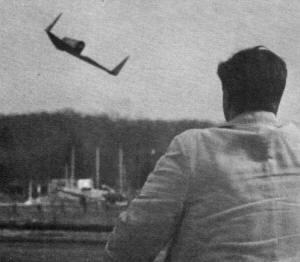
Dyna Soar launched into the wild blue yonder.
Painting and finishing: Give wing framework
a coat of clear dope wherever covering will touch. For sheet-balsa
fins, rudders and elevons plasticize dope with four drops of castor
oil per ounce of dope. This minimizes warping due to dope shrinkage.
Cover wing top and bottom with lightweight Silkspan; use one
piece for the bottom and two for the top. Run grain spanwise. The
fuselage is not paper-covered. For overall doping of completed covering,
use mixture of 1/3 thinner and 2/3 dope. Give covering three coats,
allowing each to dry, and each time apply a coat of dope to the
fuselage. After each of the first two fuselage coats, sand sheetwood
skin with fine paper.
Color scheme is dark blue fuselage and silver wings. Mix colored
dope with thinner 2/3 and 1/3 as before, apply two coats. Lettering
and insignia trim are from hobby shop decals.
Flying: Test glide model, launching it by the landing
skid. If tail heavy, add clay ballast to nose. If nose heavy bend
up elevons slightly. For best performance model should be trimmed
with elevons raised 5° to 10°. Make these initial tests
over soft grass and avoid windy weather. Aim the model at a ground
spot about 50' ahead in these hand glides.
When flying with power point nose up slightly, launch with the
same force as for hand gliding.
Further adjustments are carried out by bending individual elevons
and/or the trim tab (note bend line) of the left fin. For example,
bending up the left elevon (looking down on the craft from the rear)
will cause a right hand turn and vice versa. Never bend an elevon
down.
If more turn control is desired, or if a smoother, coordinated
turn-and-bank is needed, bend the fin trim-tab in conjunction with
elevon adjustment. Thus, bending the tab toward the center line
while bending up the left elevon, coordinates both controls for
a right turn. If Dyna-Soar turns too tightly, use opposite adjustment.
Be sure to select plenty of flying space because your Dyna-Soar
will live up to its name. It climbs like a homesick angel and probably
will come down out of sight unless adjusted to circle.
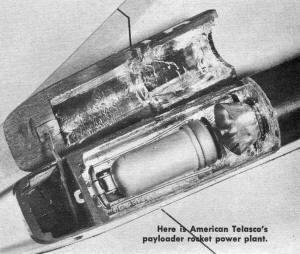
Here is
American Telasco payloader rocket power plant.
Dyna-Soar Materials:
(Balsa unless otherwise specified)
One 1/16" x 2" x 36" (medium) for fuselage sides and formers;
(1) 1/16" x 3" x 18" (soft) for fuselage top and elevons; (1) 3/32"
x 3" x 18" (medium) for fin, rudder arid engine platform; (1) 1/8"
x 2" x 18" (medium) for fuselage formers, gussets and wing fill-ins;
(1) 1/8" x 5/8" x 36" (hard) for tapered wing leading edge; (1)
1/8" x 1/2" x 18" (medium) for wing trailing edge; (2) 1/8" x 3/8"
x 36" (medium) for wing ribs and diagonals; (1) 1/8" x 1/4" x 18"
(hard) for elevon trailing edge; (1) 1/16" x 1/8" x 36" (medium)
for elevon ribs and diagonals.
Also: 1/16" plywood engine mount; aluminum foil liner; fine wire
mesh screen air inlet; 1/32" diameter wire; light weight Silkspan
covering; Pay-Loader "150" engine; clear and colored dopes; cement;
decal; .005 aluminum for augmenter tube; clay ballast.
Full size drawings for Jetex-powered model are on Hobby Helpers'
Group Plan #762A (85¢).
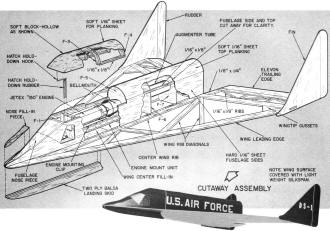
Rocket (Jetex) Powered Dyna-Soar Assembly Drawing
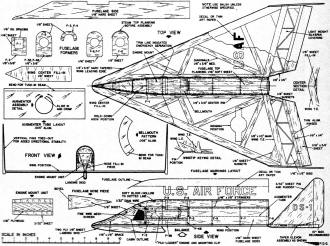
Rocket (Jetex) Powered Dyna-Soar Plans
Notice:
The AMA Plans Service offers a
full-size version of many of the plans show here at a very reasonable cost. They
will scale the plans any size for you. It is always best to buy printed plans because
my scanner versions often have distortions that can cause parts to fit poorly. Purchasing
plans also help to support the operation of the
Academy of Model Aeronautics - the #1
advocate for model aviation throughout the world. If the AMA no longer has this
plan on file, I will be glad to send you my higher resolution version.
Try my Scale Calculator for
Model Airplane Plans.
Posted June 21, 2014
|